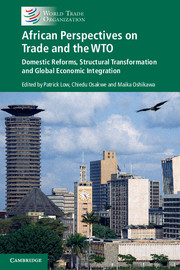 African Perspectives on Trade and the WTO
African Perspectives on Trade and the WTO from Part II - Africa’s Participation in the Rules-Based Multilateral Trading System
Published online by Cambridge University Press: 27 October 2016
African trade is heavily concentrated in agricultural and natural resource-based commodities, sectors that are highly embedded in international value chains. There has been significant trade dynamism in recent years, driven by greater participation by African firms and communities in value chains, especially in products like fresh produce and flowers. Much of this trade and production is for end markets in Europe, but there is also increasing trade of this type within Africa in some manufacturing sectors as well as within services such as tourism. Intra-regional trade remains well below potential, however, and the challenge to diversify trade and increase the value-added share of African trade continues to confront most African economies. There are improving prospects for this as a result of intra-African policy changes, ranging from a greater focus on trade facilitation to the ambition of creating a continental free trade area. A steep increase in supply chain trade in Africa is possible in coming decades if efforts continue to put in place a supporting policy environment. This must centre on substantially lowering trade costs for African firms by implementing trade facilitation measures, especially for intra-regional trade flows, and improving the productivity of transport, logistics and related services that determine the feasibility of efficiently operating regional value chains.
To save this book to your Kindle, first ensure [email protected] is added to your Approved Personal Document E-mail List under your Personal Document Settings on the Manage Your Content and Devices page of your Amazon account. Then enter the ‘name’ part of your Kindle email address below. Find out more about saving to your Kindle.
Note you can select to save to either the @free.kindle.com or @kindle.com variations. ‘@free.kindle.com’ emails are free but can only be saved to your device when it is connected to wi-fi. ‘@kindle.com’ emails can be delivered even when you are not connected to wi-fi, but note that service fees apply.
Find out more about the Kindle Personal Document Service.
To save content items to your account, please confirm that you agree to abide by our usage policies. If this is the first time you use this feature, you will be asked to authorise Cambridge Core to connect with your account. Find out more about saving content to Dropbox.
To save content items to your account, please confirm that you agree to abide by our usage policies. If this is the first time you use this feature, you will be asked to authorise Cambridge Core to connect with your account. Find out more about saving content to Google Drive.